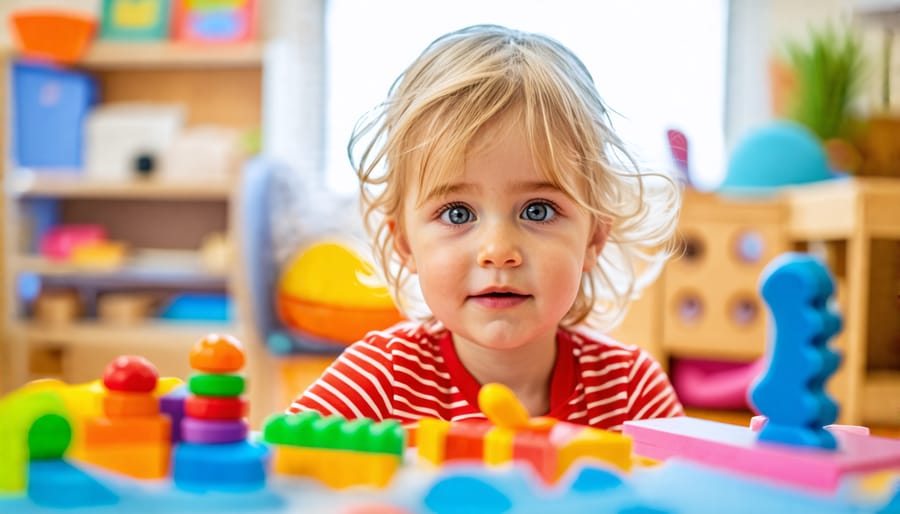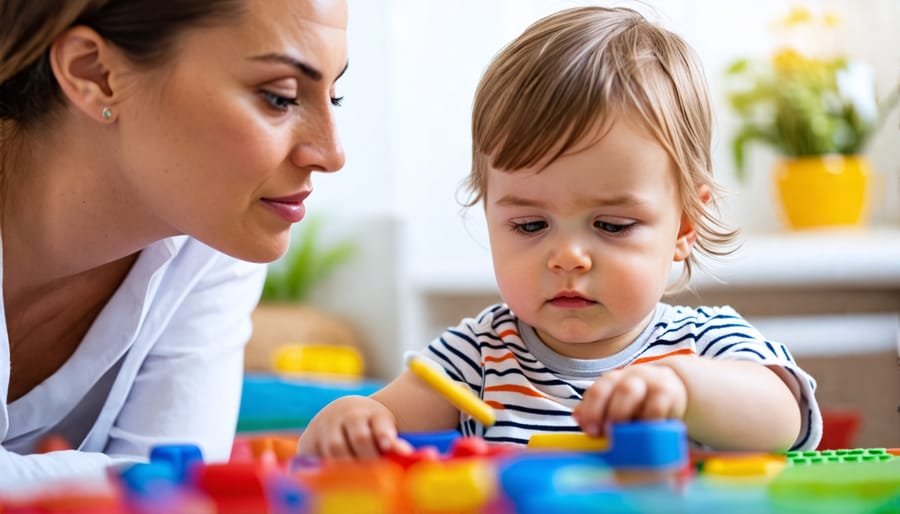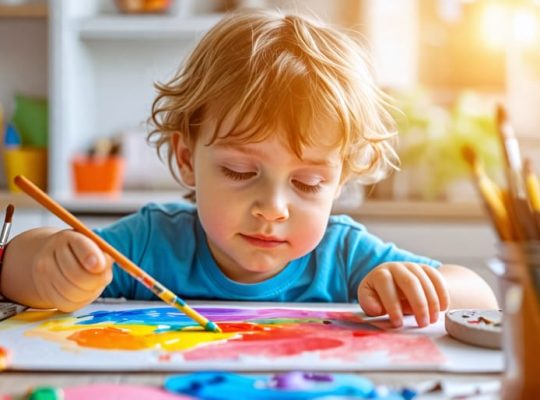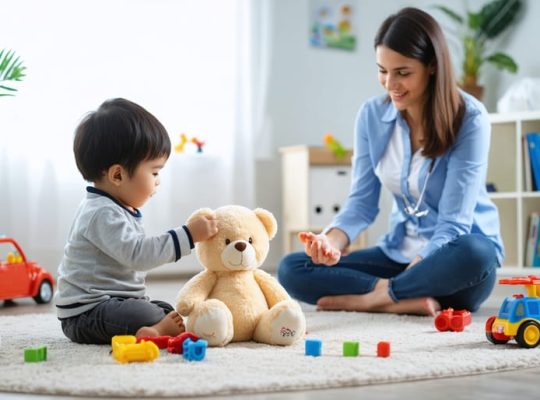Engage your child in play therapy by incorporating imaginative activities tailored to their interests, fostering emotional expression and development. Encourage role-playing scenarios where they can safely explore feelings and challenges. Incorporate storytelling, allowing your child to create narratives that mirror their experiences, facilitating a deeper understanding of their emotions. Collaborate with professionals for guidance on structured play methods, ensuring therapy meets developmental needs. Integrate diverse materials such as art supplies or toys to enhance creative expression and problem-solving skills. Prioritize a supportive environment to nurture confidence and emotional security. Explore additional resources, such as a diet guide to improve mental health, to complement play therapy’s benefits.
Understanding the Basics of Play Therapy

Definition and Principles
Play therapy is a therapeutic approach designed specifically for children aged 3-5 to help them express feelings, explore interests, and process experiences through play. It’s a compassionate method that acknowledges play as a child’s natural form of communication, akin to how adults use words. In play therapy, trained therapists use this universal language to connect with young children, allowing them to convey thoughts and emotions they may not yet fully understand or articulate verbally.
Key principles guiding play therapy include creating a safe, nurturing environment where children feel free to express themselves. Therapists adopt an empathetic, non-judgmental stance, allowing the child to lead the play while gently guiding their journey towards understanding and healing. Central to play therapy is the belief in each child’s capacity for resilience and growth, recognizing their potential to overcome struggles when given the right support. Through carefully selected play activities, children learn coping mechanisms, enhance their emotional literacy, and build stronger social skills, all in a setting that respects their pace and individuality.
Why Focus on Ages 3-5?
During the ages of 3 to 5, children are in a critical phase of development where they rapidly acquire essential cognitive, emotional, and social skills. This period is characterized by an explosion of language, imagination, and the ability to form relationships. Play therapy is particularly powerful for this age group because it leverages their natural mode of expression—play itself. At a time when children might struggle to articulate their thoughts and emotions verbally, play offers a safe and familiar avenue for them to convey their internal world.
Through play therapy, children can process complex feelings, build self-confidence, and learn problem-solving skills in a supportive environment. Expert opinions highlight that early intervention, such as play therapy, can significantly impact a child’s mental health trajectory by fostering resilience and emotional intelligence. Personal stories from parents and therapists alike often describe transformative shifts in behavior and emotional well-being, underscoring the therapy’s profound impact during these formative years. With understanding and patience, we can nurture their development effectively, setting a strong foundation for the future.
Benefits of Play Therapy for Young Children

Emotional Expression and Regulation
Play therapy offers a gentle way for young children to express and manage their emotions. At ages 3-5, kids may not yet have the words to describe how they feel, so they communicate through play instead. Through engaging activities like drawing, using dolls, or building with blocks, children can express complex emotions in a safe and supportive environment. This form of therapy helps them feel understood, validated, and less overwhelmed by their feelings.
During play, therapists observe and gently guide children, introducing regulation techniques tailored to each child’s needs. For example, if a child is upset during a role-play scenario, the therapist may help them practice taking deep breaths or pausing to think. As children explore different scenarios in play, they gradually learn to name their emotions and discover healthy ways to cope with challenges. Alongside these techniques, play therapy empowers children, building their emotional resilience and helping them develop healthier relationships with themselves and others.
Enhancement of Social Skills
Play therapy serves as a valuable tool in enhancing social skills among young children. Through guided play, kids learn how to communicate, share, and collaborate with others in a safe and nurturing environment. Imagine a shy child gradually learning to express themselves through play, supported by a therapist who gently encourages interaction with peers. This process builds confidence and fosters empathy, as children begin to understand different perspectives and emotions. Simple activities like role-playing help them practice social cues and develop friendships. By nurturing these skills, play therapy sets the foundation for healthy relationships and emotional well-being as they grow.
Building Coping Mechanisms
Play therapy offers a unique way for young children to develop and enhance their coping mechanisms through imaginative play. By engaging in this therapeutic process, children use toys and creative activities to express emotions they might not yet have the words for. This playful environment serves as a safe space where they can confront difficult feelings, practice emotional regulation, and learn problem-solving skills. For instance, if a child consistently builds towers only to knock them down, a therapist can guide them in exploring these actions to boost their resilience. Witnessing the success of such sessions reassures parents and educators of the profound impact play therapy can have on nurturing healthy emotional growth.
How Play Therapy is Conducted
Common Techniques and Approaches
In play therapy for young children aged 3-5, several common techniques and approaches help facilitate healing and emotional growth. One key method is called child-centered play therapy, where the child leads the play, and therapists follow, offering a safe space for expression. This approach builds on children’s natural ability to communicate through play, rather than words. Another popular method, directive play therapy, involves more structured activities guided by the therapist, who might introduce specific toys or games to address particular issues or teach coping skills. Both methods are gentle and nurturing, ensuring children feel secure in expressing their feelings. Some therapists might incorporate sensory-based activities, such as sand tray therapy or art-based interventions, allowing children to process emotions creatively. Incorporating therapeutic techniques like these can be tremendously beneficial for young children, providing them a warm and accepting environment to navigate their emotions and experiences. Parents and educators often appreciate how these approaches can support a child’s emotional resilience and mental well-being.

Role of the Therapist
In play therapy for 3-5-year-olds, the therapist plays a pivotal role by gently guiding and observing the child’s play, creating a safe and trusting environment. This professional becomes a compassionate companion, helping the child express emotions, solve problems, and build resilience through their natural language of play. By skillfully interpreting the child’s actions and words, the therapist gains insights into their inner world, unlocking understanding and promoting healing. With empathy and patience, the therapist encourages creativity and exploration while offering support and boundaries. This nurturing process empowers the child to address feelings and experiences that might be challenging to express verbally.
Real-Life Success Stories
Play therapy has transformed the lives of many children, making a noticeable difference in their mental health and well-being. Take Liam, a four-year-old whose parents worried about his increasing withdrawal and anxiety. Through play therapy, Liam was able to express emotions he couldn’t articulate in words. As he played, his therapist helped him navigate his feelings, offering him a safe space where he felt heard and understood. Over time, Liam became more confident and started interacting positively with other kids, a significant shift that brought relief to his family.
Similarly, Emily, a preschool teacher, has witnessed the profound impact of diet and play therapy in her classroom. When a student named Ava struggled with aggression and outbursts, Emily recommended play therapy to Ava’s parents. The sessions provided Ava not only an outlet for her emotions but also a structure to cope with them. As Ava engaged in different activities, she learned critical social skills that improved her interactions with peers, making a harmonious classroom environment possible.
Health professionals also share compelling accounts, like Dr. Rose, a child psychologist, who has seen play therapy help young patients develop resilience. She mentions how a patient with early childhood trauma used play as communication, gradually building trust and emotional resilience through creative expression. These real-life stories highlight the power of play therapy—demonstrating its effectiveness in offering children new ways to understand themselves and the world around them. Through compassionate guidance, play therapy continues to be a beacon of hope for many families seeking support.
Expert Opinions on Play Therapy
Play therapy is a beacon of hope for many parents and caregivers, according to experts in child psychology. It offers a compassionate approach to helping young children express what might be troubling them when words alone aren’t enough. Child psychologists often highlight how play is a natural form of communication for children aged 3-5; it’s their language and through it, they can work through problems and understand their emotions better.
Mental health professionals agree that play therapy can be incredibly effective in supporting children’s emotional and psychological well-being. Dr. Linda Gross, a respected child therapist, shares that “play therapy gives children the opportunity to play out their feelings and problems in a safe environment, leading to insights and emotional healing.” This sentiment is echoed by numerous studies and clinical experiences, showing positive outcomes in children who engage in play therapy.
Introducing play therapy in a child’s life can be a supportive measure alongside other strategies to support mental well-being. Encouragingly, experts advise that creating a nurturing and open environment where a child feels safe to express through play can significantly aid their development. By equipping children with the tools to explore and understand their feelings, play therapy lays the foundation for healthier coping mechanisms in the future.
Practical Tips for Parents and Caregivers
Supporting play therapy at home can be a rewarding experience for both you and your child. Encouraging regular playtime is a simple yet impactful way to reinforce therapeutic progress. Set aside a specific time each day where your child can engage in free play, letting their imagination guide them. This routine not only complements professional therapy sessions but also offers a secure environment where kids feel comfortable expressing themselves.
Don’t worry if you’re unsure about how to get started—remember that the goal is to observe and support rather than direct the play. Follow your child’s lead during playtime, showing interest in what they choose to engage in. This active participation helps build trust and strengthens your bond.
Incorporate a variety of toys and materials that can evoke creativity and expression, such as art supplies, puppets, or building blocks. These tools can provide children with different ways to explore emotions and situations that might be challenging to articulate verbally.
Lastly, reflect on the play by discussing the stories or themes that emerge. Gently ask open-ended questions like, “What do you like most about this game?” or “How does this make you feel?” This approach encourages your child to articulate their thoughts and emotions, further supporting their mental health journey.
Conclusion
In conclusion, play therapy represents a transformative approach to enhancing children’s mental health, particularly for those aged 3-5. Through the natural act of play, children are given a safe space to express their emotions, develop problem-solving skills, and build resilience. This therapeutic method is not only supportive but also empowering, as it taps into the playful nature inherent in every child. By embracing this approach, parents, teachers, and healthcare professionals can effectively contribute to a child’s emotional and social well-being. Understanding the profound impact of play therapy encourages us all to nurture this early stage of mental health development with empathy and care.







